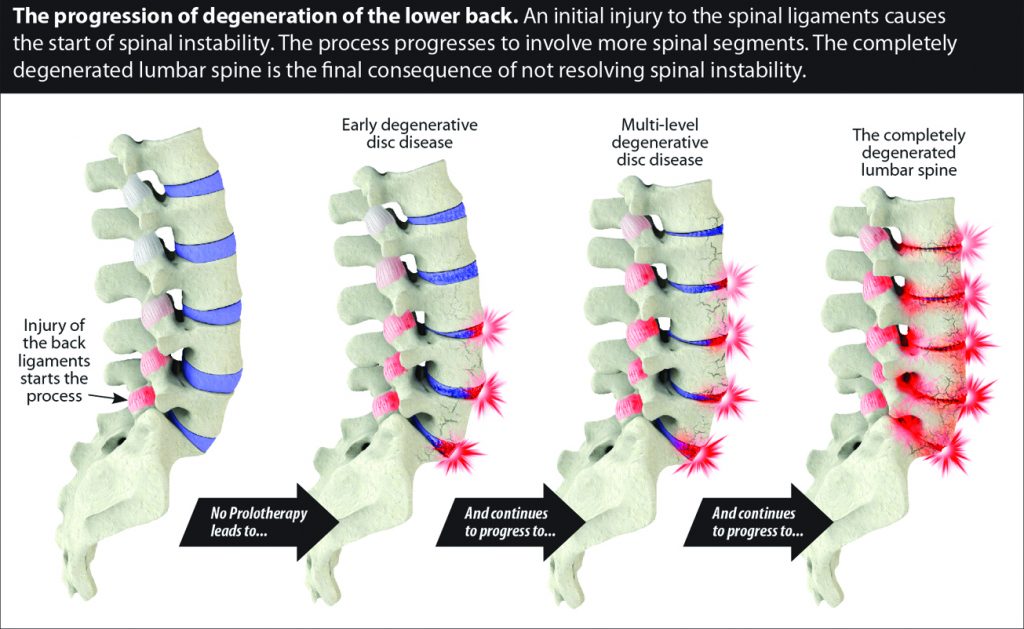By Debra K. Brinker, RN
Many people know someone who suffers from back pain and has accepted it as a part of life. In fact, almost half of us have some sort of spinal pain coming from our neck, mid-back, or lower back. Did you know that back pain is most often the result of spinal instability caused by injured ligaments? The injury may have occurred with sudden movements and poor body mechanics or from trauma during a sports activity, fall or motor vehicle accident. Acute back pain often resolves on its own or with exercise, physical therapy, or chiropractic treatments. However, when back pain lingers for a few months, and worsens, it is often the beginning of the degenerative progression of chronic back pain. This is indicative of unhealed ligament damage which leads to spinal instability.
Cumulative trauma and wear and tear injuries, through years of sports and other activities, can result in small tears of the ligaments. Ligaments, unlike muscles, lack a great blood supply and, therefore, have a poor ability to heal on their own. This is why injuries to the ligaments can still cause pain in those who have good muscle strength—chronic pain is not a muscle problem, rather, it is a ligament problem. Injured ligaments allow excessive motion between the spinal segments. The spinal instability causes chronic back pain and continued degeneration of the surrounding structures, unless the ligament tissue is regenerated. This similar etiology is seen through numerous back pain symptoms and diagnoses. (See Figure 1.)

Disc Degeneration and Herniated Discs
The key factor in both conditions is ligament laxity/damage. Degenerative disc disease refers to the condition where one or more of the intervertebral discs in the spine gradually deteriorate and which may or may not cause pain. Disc degeneration occurs when ligaments around the spine are injured. In herniated disc cases, the disc actually herniates through the surrounding ligament tissue. When the ligaments around the spine are injured, excessive joint mobility occurs and the bones (vertebrae) move too much, creating vertebral instability. The excessive motion causes abnormal forces and pressure on the discs between the vertebrae, which produces the degeneration of the discs. (See Figure 2.)

When the ligaments become stretched out or injured, the muscles tighten and generate pain. Therefore, with bending, turning and other vertebral movement, the nerve fibers in the ligaments start firing and sending pain signals. Ligaments are highly innervated, and with injury, will elicit pain. If the ligaments are unable to stabilize the vertebral movement, the muscles are overworked to the point of constant tightness and spasm, while the body overgrows bone. This bony overgrowth produces the loss of motion noted in osteoarthritis, as the body tries to stabilize the spine.
Spinal Stenosis
The formation of bone spurs may lead to a narrowing of the spinal canal, and a condition called spinal stenosis. This diagnosis is made when a specific type and amount of narrowing develops, causing a neurologically-based pain, such as leg or back pain while walking or bending. Not all cases require surgery, especially when symptoms are present only upon activity and resolve with rest. This can be referred to as Spinal Stenosis At Rest (SSAR) or Spinal Stenosis With Activity (SSWA). (See Figure 3.)

When pain is positional, it is a good indication of ligament damage and spinal instability. This means that pain is worse with certain positions or activities, and remits upon changing position or at rest. The lax ligaments allow the spinal segments to move and pinch nerves that create painful symptoms. What’s more, these cases are responsive to Regenerative Medicine and do not always require surgery, as many people too quickly assume.
Failed Back Surgery Syndrome
Unfortunately, a large percentage of surgeries for disabling low back pain culminate with recurrent or persistent pain, numbers so overwhelming, the condition has its own diagnosis: Failed Back Surgery Syndrome. The condition leaves the patient terrified about going through another surgery or the prospects of living in pain and on pain medication. This diagnosis indicates that the original reason for the back pain was not addressed by surgery. Regenerative injection therapy can offer a solution, by healing the original ligament injury, as well as the ligaments traumatized by the surgery itself.
Relieving back pain for the new year
New year resolutions often include improving one’s health. Looking for permanent options to relieve back pain once and for all is an excellent goal. Regenerative Medicine options, such as Prolotherapy and Stem cell therapy provide successful non-surgical options for chronic back pain to finally be permanently relieved. (See Figure 4.)

These regenerative injection treatments help by stimulating the body to repair damaged/overstretched ligaments, thus, stabilizing the vertebral segments and eliminating the root cause of most chronic back pain.
Regenerative Medicine Specialists
CaringMedical.com
239-303-4546
with locations in Fort Myers and Chicagoland









